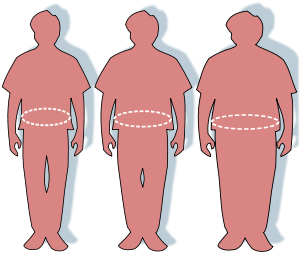Waist
| Waist | |
|---|---|
 The human waist | |
| Identifiers | |
| FMA | 228775 |
The waist is the part of the abdomen between the rib cage and hips. On people with slim bodies, the waist is the narrowest part of the torso.
The waistline refers to the horizontal line where the waist is narrowest, or to the general appearance of the waist.
Structure
Because of this and because the waist is often synonymous with the stomach, one can become confused as to the exact location of the waist. Another confusing factor is that the waistline differs on different people. To locate the natural waistline, one need simply stand upright and then tilt over to the side keeping the legs and hips straight. Where the torso creases is the natural waistline.
Waist measurement
Strictly, the waist circumference is measured at a level midway between the lowest rib and the iliac crest.[1] The waist-hip ratio equals the waist circumference divided by the hip circumference. Practically, however, the waist is usually measured at the smallest circumference of the natural waist, usually just above the belly button for women and just below the belly button for men.[2] In case the waist is convex rather than concave, such as is the case in pregnancy and obesity, the waist may be measured at a vertical level 1 inch above the navel.[3]
The size of a person's waist or waist circumference, indicates abdominal obesity. Excess abdominal fat is a risk factor for developing heart disease and other obesity related diseases. The National Heart, Lung, and Blood Institute (NHLBI) [4] classifies the risk of obesity-related diseases as high if men have a waist circumference greater than 102 cm (40 in) and women have a waist circumference greater than 88 cm (35 in).
A study published in the European Heart Journal April 2007 [5] showed that waist circumference and waist-hip ratio were predictors of cardiovascular events.
Waist–hip ratio
Waist–hip ratio is the ratio of the circumference of the waist to that of the hips. It measures the proportion by which fat is distributed around the torso.
Waist–hip ratios of 0.7 for women and 0.9 for men have been shown to correlate strongly with general health and fertility. Colloquially this shape is compared to the hourglass shape.[6]
Society and culture
Fashion
In modern clothing the region referred to as the waist is considerably below the waist as defined anatomically. With the advent of pants and skirts that do not require support from above, the clothing waist moved down to a position where the body starts to expand to form the buttocks and a support is therefore available. The waistline of clothing is now generally well below the anatomical waist.
Jewellery, such as a belly chain, may be worn around either the clothing or anatomical waist.
Waist reduction and training
Waist reduction or waist training refer to the act of wearing a corset or other constricting garment to reduce or alter the waistline. The four floating ribs may be permanently compressed or moved by such garments. A girdle may also be used to alter the appearance of the waist.
Waist reduction may be used simply to reduce the width of the waist. This change can be permanent or temporary.
Waist training may be used to achieve a certain permanent waist shape, such as a pipe-stem waist.
History
Etymology
Definition: "middle part of the body," also "part of a garment fitted for the waist, portion of a garment that covers the waist" (but, due to fashion styles, often above or below it), probably from Old English *wæst "growth," hence, "where the body grows," from Proto-Germanic *wahs-tu- (cognates: Old English wæstm, Old Norse vöxtr, Swedish växt, Old High German wahst "growth, increase," Gothic wahstus "stature," Old English weaxan "to grow".[7]
See also
- Abdominal obesity
- Alvinolagnia
- Belly dance
- Body modification
- Human body
- Midriff
- Navel
- Rib removal
- Waist–hip ratio
- Category:Corsetry
References
- ↑ Han, T.; Van Leer, E.; Seidell, J.; Lean, M. (1995). "Waist circumference action levels in the identification of cardiovascular risk factors: prevalence study in a random sample". BMJ (Clinical research ed.). 311 (7017): 1401–1405. doi:10.1136/bmj.311.7017.1401. PMC 2544423
 . PMID 8520275.
. PMID 8520275. - ↑ Waist To Hip Calculator at University of Maryland Medical System. Retrieved Dec 2010
- ↑ Brown JE, Potter JD, Jacobs DR, et al. (January 1996). "Maternal waist-to-hip ratio as a predictor of newborn size: Results of the Diana Project". Epidemiology. 7 (1): 62–6. doi:10.1097/00001648-199601000-00011. PMID 8664403.
- ↑ "Obesity Education Initiative, Aim for a Healthy Weight".
- ↑ Lawrence de Koning; Merchant, AT; Pogue, J; Anand, SS (2007). "Waist circumference and waist-to-hip ratio as predictors of cardiovascular events: meta-regression analysis of prospective studies". European Heart Journal. 28 (7): 850–6. doi:10.1093/eurheartj/ehm026. PMID 17403720.
- ↑ Female Body Characteristics Related to Bra Fit - Page 20, 2007
- ↑ http://www.etymonline.com/index.php?term=waist
External links
-
 "Waist". Encyclopædia Britannica (11th ed.). 1911.
"Waist". Encyclopædia Britannica (11th ed.). 1911. - Measured average height, weight, and waist circumference for adults ages 20 years and over (U.S.)